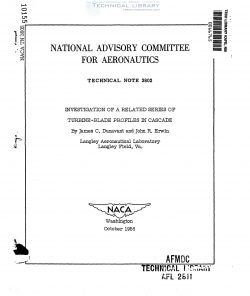naca-tn-3802
- Version
- 126 Downloads
- 2.66 MB File Size
- 1 File Count
- January 29, 2017 Create Date
- January 29, 2017 Last Updated
National Advisory Committee for Aeronautics, Technical Notes - Investigation of a Related Series of Turbine Blade Profiles in Cascade

An application of airfoil design methods was used to design series
of related turbine-blade profiles to satisfy the conditions of inlet flow
angle and turning angle encountered in the usual range of turbine operation
A series of blade profiles applicable to most turbine blading requirements
and a secondary series with particular reference to impulse conditions were
designed. Five blade sections ofrom these series ranging in mean-line
turning angles from 65° to 120° were tested in lowaspeed cascade tunnels.
From.low;speed—test results Optimum blade angles of" attack were selected
at each test condition. The induced angle and the deviation angle of the
flow were determined from the low-speed data. If these angles are known
for the solidity and inlet angle of an application, the necessary camber
is specified. A method of predicting high-speed pressure distributions
from low—speed cascade—test results is presented to extend the usefulness
of the low-speed.data. Sample high-speed tests of two of the_five blade
sections were made at Mach numbers up to the critical value. The results
indicated satisfactory flow conditions in all the blade passages tested.
Current methods of selecting turbine blade sections are based largely
on empirical rules derived from experience with steam and gas turbines.
In many applications satisfactory results have been obtained but no system-
atic method of designing suitable turbine blade sections has been published.
In the case of closely spaced, highly cambered blades such as are encoun-
tered in turbine practice, the theoretical determination of the blade
shapes is a difficult problem. A number of theoretical methods of varying
degrees of approximation have appeared (for example, refs. 1 to 5).
For isolated airfoils it is possible by theoretical means to derive
the pressure or velocity distribution about a given profile. On the
basis of this theory a simple procedure has been developed (ref. 6) in b
which the theoretically determined basic thickness distribution and mean H
camber line are superimposed to determine the shape of the isolated pro-
file corresponding to any desired presSure distribution.
| File | Action |
|---|---|
| naca-tn-3802 Investigation of a Related Series of Turbine Blade Profiles in Cascade.pdf | Download |

Comment On This Post